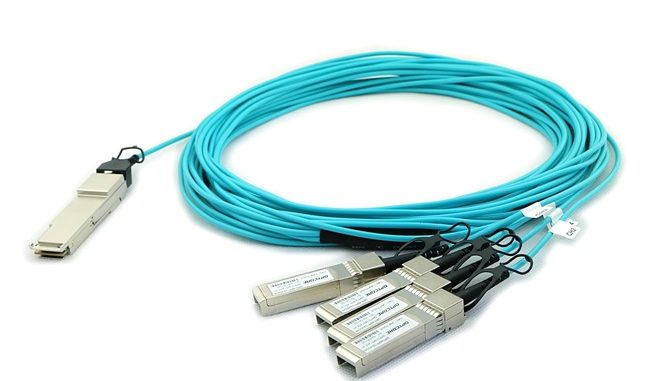
AOC active optical cable, also known as fiber optic cable with a chip. The traditional data center interconnection is mainly based on coaxial cable, and AOC active optical cable has many significant advantages compared with interconnected copper cable. For example, the transmission power on the system link is lower, the weight is only one-quarter of the direct copper cable, the volume is about half of the copper cable, and it has better airflow heat dissipation in the equipment room wiring system, and the cable bends. The folding radius is smaller than that of the copper cable, the transmission distance is farther (100 to 300 meters), and the bit error rate of the product transmission performance is also better, and the BER can reach 10^-15.
Compared with the optical transceiver module, the AOC active optical cable has a non-exposed optical interface, and there is no problem that the optical interface is clean and contaminated, the system stability and reliability are greatly improved, and the maintenance cost of the equipment room is reduced.
Active optical cable products based on optical engine technology are the best solution for high-speed optical interconnection in data centers and are an inter-chip interconnect structure. At present, mainstream high-speed optical interconnect AOC products include 10G SFP+ AOC, 40G QSFP+AOC, 56G QSFP+AOC, and 120G CXP AOC.
What is a 40G QSFP+ AOC active cable?
40G QSFP+ active optical cable is the core component of parallel optical interconnection. It consists of two high-speed 40G parallel connectors connected by ribbon fiber jumpers. Each signal direction has 4 data channels, and each channel can work at 10Gbps speed. The transmission distance is generally from 1 to 100 m, and the length of the cable at both ends of the splitter can be freely selected.
Compared with the traditional 40G copper cable, 40G AOC active optical cable has incomparable advantages in data transmission environment of more than 7 meters, such as incomparable advantages: high transmission efficiency, small size, light weight, low energy consumption.
Compared with the optical module, the connector has no cleanliness problem in the event of a failure, no need to test the terminal plug, which can help the user save more time; the AOC wiring is more consistent and repeatable, and the closed ends are easier to avoid the environment. And the effect of vibration sway, if it fails, it can be replaced directly, saving cost; the advantage of AOC relative to the optical module is that the price is much cheaper, the deployment cost can be saved, and the transmission distance can also meet the requirements of various short-distance transmission applications.
40G QSFP+ AOC application
High-speed optical interconnect products 40G QSFP+ AOC and 120G CXP AOC no longer adopt the structural design of TOSA/ROSA in traditional pluggable transceivers but use highly integrated array light engine core device technology. Achieve integrated mode—small package, high speed, low power consumption (QSFP+ power consumption is less than 1.5W, CXP power consumption is less than 2.5W).
At the transmitting end, the array optical engine processes multiple high-speed electrical channels simultaneously convert them into multiple optical signals and combine these optical signals together to transmit this information through a 12-core (24-core) MPO high-density cable. The next node in the cloud computing system or data center room.
At the receiving end, the array optical engine converts the optical signals in the MPO cable back into electrical signals and transmits the multiple electrical signals to the device for processing. These products are fully applicable to the InfiniBand interconnect application scenario while complying with Ethernet IEEE 802.3ba. In the field of cloud computing systems, array optical engine technology has been widely used in active optical cable products – the interconnection between servers and switches.